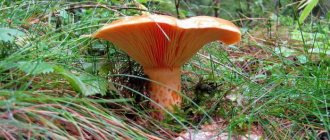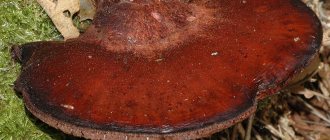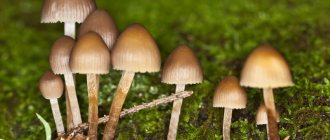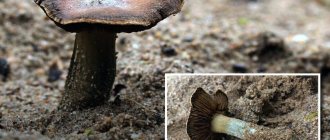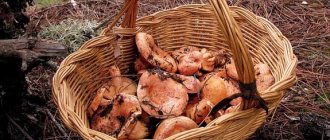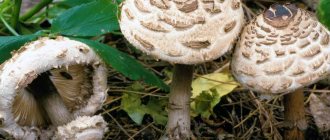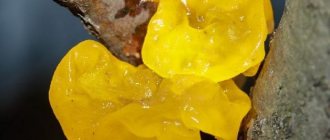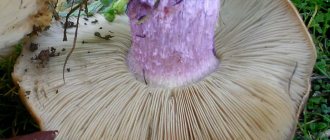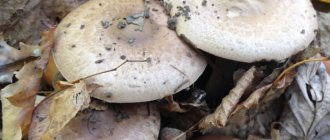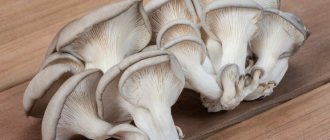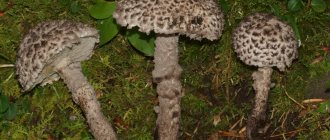It is not for nothing that the satanic mushroom (lat. Boletus satanas) received such a sonorous and ominous name. Its cunning lies in its rare ability to imitate its edible relatives. It is difficult for an experienced mushroom picker to confuse the “devil’s mushroom” with the edible boletus mushroom, popularly known as the “white mushroom”. You can distinguish a lover of mimicry from the “king of mushrooms” by the reddish color of the stem.
Chemical composition, characteristics and brief description of the structure
The main danger of this fruiting body is that its appearance is very similar to an ordinary boletus. However, the Satanic mushroom belongs to the tubular mushroom, family Boletaceae (Boletaceae), genus Rubroboletus, species Rubroboletus satanas (Satanic mushroom). Latin names: Rubroboletus satanas, Boletus satanas. People also call it Satanic Bolet, Satanic Boletus.
Interesting to know! The satanic mushroom also received other names: forest devil, devil's mushroom, Satan.
Such frightening, gloomy names are assigned to this representative of the forest kingdom only because it contains toxic substances - alkaloids, which in their effect are similar to the heavy toxin muscarine (part of the fly agaric).
That is why this species is classified as not just conditionally edible, but poisonous mushrooms.
The cap is characterized by a hemispherical, cushion-shaped shape, its diameter is from 8 to 30 cm. In adulthood, it becomes more prostrate, smooth and velvety to the touch.
Its color is closer to dirty gray, olive-grayish, sometimes an ocher, yellowish tint and greenish or yellow-pink stains appear.
The hymenophore (this is the lower part of the cap) of the forest devil is tubular. The tubes of a young mushroom are yellowish, later becoming greenish-yellow.
The pores are small, initially yellow, with age they become orange, red, red-brown, and when pressed they turn blue-green.
The flesh is pale, almost white, slightly blue when cut. The mouths of the tubes are red. The aroma of the pulp in young specimens is weak and spicy, while in older specimens it is similar to the smell of carrion or rotten vegetables.
The structure of the leg is similar to the classic boletus: massive, barrel-shaped, tapering towards the cap. The height of this part can reach 6–15 cm, and the thickness from 3 to 10 cm.
The color of the leg closer to the cap and at the base is yellowish; in the middle part it is red or orange-red, and has a barely noticeable mesh pattern.
A little history
Boletus satanas was first described by the German mycologist Harald Othmar Lenz in 1831. This scientist gave it this ominous name after he felt sick after eating the mushroom.
Much later, in 2014, the satanic boletus was transferred to the new genus Rubroboletus, along with several other related reddish-red, blue-colored Bolete species.
Special signs
What does a satanic mushroom look like? If you cut the leg of a forest devil, the blue color will appear first, and then bright red. By this sign you can find out whether this species is poisonous or not. In addition, the flesh of the devil's mushroom has the smell of rotten onions or, according to some experts, may resemble the stench of carrion. Young specimens sometimes have no smell at all.
Note! If you cut the stem and it turns blue within 3-5 minutes, then this mushroom should be thrown away immediately, since in edible species the color of the flesh does not change when cut.
Edible or not?
In the specialized literature, this species is classified as conditionally edible. However, using satanic mushrooms for food without prolonged soaking and cooking for at least 10 hours is unacceptable. If you neglect these conditions, you can be seriously poisoned.
Despite the fact that biologists classify satanic mushrooms as conditionally edible, experts do not recommend risking your health and collecting them, since the amount of poison cannot be determined at home. Some sources contain evidence that this type of mushroom is definitely poisonous.
Rules for preliminary preparation
Those who still want to taste Boletus Satanas need to know the basic rules for the preliminary preparation of conditionally edible mushrooms for consumption. But remember - some scientific sources claim that the toxins contained in this mushroom are not completely destroyed even after heat treatment.
- Try to collect only the youngest fruiting bodies possible - the younger they are, the less toxins they contain.
- Clean the fruiting bodies from dirt and damaged areas.
- Soak them for three hours in clean water.
- Boil in slightly salted water for 30-40 minutes.
After preliminary boiling, the Satanic Mushroom is suitable for further culinary processing. Expert experimenters claim that after cooking, the bitterness and unpleasant odor characteristic of old fruiting bodies disappear. Fans of extreme mushrooms usually fry Boletus Satanas after boiling and claim that it’s okay - you can eat it.
Difference between false doubles of poisonous mushroom
Many lovers of quiet hunting can often confuse this species with completely harmless conditionally edible or edible mushrooms.
This is not surprising, because all representatives of Boletidae are very similar to each other. In addition, they may turn blue when cut when pressed.
For example, the white boletus (Boletus albidus) and the inedible boletus (Boletus calopus) are non-poisonous and are classified as conditionally edible, as they have a characteristic bitter taste. And the edible olive-brown boletus (Boletus luridus) and speckled boletus (Boletus erythropus) have a darker, brown cap. But it also happens the other way around, when boletus or poddubniks are mistaken for forest devils and are not put in the basket.
Beautiful boletus (Caloboletus calopus)
Boletus erythropus
How to distinguish from a subdubnik?
The main difference between the satanic mushroom and the completely harmless, tasty mushroom (Boletus erythropus) is the color of the cap. In the first it is white with a gray tint, and in the “Polish” (as the people call the poddubnik) it is always brown and dark.
The cut flesh of an edible mushroom can also turn blue, but not as intensely as that of its poisonous counterpart.
Where does it grow?
The mushroom prefers light deciduous forests. Likes to grow in hazel thickets, under hornbeams and beeches, among lindens and chestnuts. Distributed in southern Russia, the Caucasus and the Middle East, and southern Europe. It grows from early summer until October. Favorite soil is limestone.
In Russian forests, fortunately, the satanic boletus is a rare resident. This is confirmed by the absence of numerous names. Frequently occurring species, as a rule, have dozens of names invented by the people. Among the few names of this mushroom is satanic bolete. From Latin “bolet” is translated as “boletus”.
Toxicity, signs of poisoning and first aid
During satanic sickness poisoning, vomiting and indigestion occur, with the urge becoming more frequent and intense over time.
In some cases, there is even paralysis of the limbs, fainting, and severe headaches. Death can occur from suffocation or cardiac arrest.
It is believed that the pulp of mushrooms, previously subjected to heat treatment, does not contain toxins, but it is better not to risk your health.
It is important to know! You can get poisoned by consuming even 1–2 grams of the fruiting bodies of the satanic boletus.
In case of intoxication, you should immediately call a doctor (ambulance) and induce vomiting in the patient by drinking a weak solution of potassium permanganate or mineral water with salt.
It is very important at the initial stage to take a large amount of sorbents (activated, white carbon, enterosgel) in order to neutralize the effects of muscarine.
Difference from dubovik
Speckled Oak (Neoboletus erythropus)
These two species are surprisingly similar, sometimes so much so that even experienced silent hunters cannot tell the differences. But they still exist, and they are worth knowing so as not to harm your health.
Similar features: both species can turn blue when the flesh is pressed, they are similar in appearance, and grow in approximately the same period.
Criteria by which you can determine a deadly poisonous species from oakweed:
- Pay attention to the reaction of the fruiting body when damaged. The dubovik immediately changes color and looks like a bruise. But the forest devil does not turn blue immediately, but after some time. At the same time, it first turns red, and only then acquires a characteristic blue color.
- Flesh color. The dubovik has a light yellow, almost lemon tint to this part, and the devil's mushroom is white.
- Hat color. In the edible species it is olive, sometimes orange, and in the poisonous species it is grey-green or grey.
In more detail, all the differences can be determined from the photo. There are many videos on the Internet from specialists and ordinary lovers of quiet hunting about the distinctive signs of satanic disease.
Interesting Facts
The pain is satanic.
It is believed that the satanic mushroom was named this way because of its high toxicity. According to some sources, just 1 gram of raw satanic mushroom pulp can cause severe poisoning. Moreover, despite the fact that in some countries they still eat it after boiling, this way is not considered to get rid of toxins. Another version of why the mushroom could be called that is the red leg (identified with the reflections of hellfire).
Signs of satanic mushroom poisoning are:
- Uncontrollable vomiting.
- Diarrhea.
- Paralysis of limbs.
- Severe cephalgia (head pain).
- Loss of consciousness.
As a result of satanic mushroom poisoning, respiratory depression and cardiac arrest may occur, therefore, if the above symptoms are detected, it is important to call medical help as soon as possible, and while waiting for an ambulance, flush the stomach.
Dangerous twins
Satan's boletus resembles other boletaceae with bluish flesh and colored spores. Among the inedible representatives, the devil's mushroom can be confused with the following species:
- The whitish boletus is not eaten because of its bitter taste;
- Boletus is pink-golden;
- Boletus inedible also has a bitter taste and is therefore inedible;
- Boletus le Gal or legal boletus;
- False satanic mushroom.
The latter type is called “false” for a reason, so it is worth dwelling in more detail on the differences between these two satanic mushrooms.
| Satanic mushroom | False satanic mushroom | |
| Name in Latin | boletus satanas | boletus splendidus |
| Toxicity | Poisonous | Conditionally edible |
| hat | Up to 30 cm, hemispherical or rounded-pillow-shaped, and then prostrate. The surface is smooth or slightly velvety, without moisture. | Dimensions: 5.5-10.5 cm, cushion-shaped, convex, with sharp and protruding edges. The surface is free of moisture, slightly felty or completely smooth. |
| Color | Most often whitish or grayish, but can be dirty gray or olive gray, with yellowish or ocher tinges and streaks | Milky coffee or brown with a pinkish tint |
| Pulp | White or yellowish in color, with moderate bluing or redness on the cut | Delicate consistency, light yellow in color, reddish or blue when cut |
| Leg | No more than 15 cm in length and up to approximately 9–10 cm thick, tuberous or barrel-shaped with a narrowing at the top, dense. The coloring at the top is yellowish-red, and at the base the color is brownish-yellow. The presence of a mesh cellular pattern. | No more than 8 cm with a diameter of 5 cm. Cylindrical in shape with a pronounced narrowing at the base. The surface is yellowish in color, with a carmine tint at the base, and covered with a thin mesh pattern. |
Mushrooms with effects on the nervous system
The talker is whitish
The talker is whitish
The whitish Govorushka from the genus Govorushka has a fruiting body that does not have a clear division into a stem and a cap. The diameter of the initially convex and then saucer-shaped cap with a wavy edge reaches 4 cm. The cap may have a whitish, pinkish or grayish tint.
There is a powdery coating on the surface of the cap. The cap, which is dry in hot weather, becomes slimy when the humidity rises. The whitish elastic flesh of the mushroom does not darken when cut, has a pleasant sweetish smell and a characteristic mushroom taste. The stem does not exceed a height of 4 cm with a thickness of about 1 cm. The stem of a young fruiting body is dense; as it matures, a cavity appears in it.
The whitish talker grows in open areas of the forest, as well as in meadows and pastures, usually in groups. Fruiting bodies develop from mid-summer to mid-autumn. An inexperienced mushroom picker may confuse the white talker with the edible Honeydew or meadow mushroom. Therefore, if you are not sure that this is an edible hornbeam, then it is better to leave your find where it is.
The whitish talker contains the toxic substance muscarine, which leads to severe poisoning. Fortunately, this usually does not lead to death, since this requires eating a very large amount of mushrooms of this type and there is an antidote - atropine. However, vomiting, diarrhea, respiratory and cardiac problems are a terrible punishment for an inattentive mushroom picker and his innocent loved ones.
Cracked fiberglass
Cracked fiberglass
Fiberwort fissured, from the genus Fiberwort, is a very poisonous mushroom. It doesn’t catch the eye, but if it ends up in a mushroom picker’s basket, trouble will follow. To prevent this from happening, you need to carefully remember the appearance of the fissured fibre.
The caps of young fruiting bodies of the fungus resemble a bell, and then straighten out like an umbrella, often cracking radially. Hence the name and the instruction to mushroom pickers that this mushroom is not worth taking.
Silky to the touch, slippery in wet weather, the cap can be golden yellow, pale yellow or honey brown, with the center of the cap being more deeply colored. Mushroom pulp is white with an unpleasant odor. A stem 1 cm thick will raise the cap to a height of 11 cm, maybe a little lighter than the cap, the top of the stem is finely mealy.
Fiberwort lives in forests of various types; on loamy soils, especially many fruiting bodies are formed in August-September. The only way to confuse fissured fibergrass is with mayweed. It is guaranteed that these mushrooms can be distinguished by their smell. In the row it is flour. However, it is better not to take risks, since fiber contains large quantities of muscarine and eating it can end tragically.
Fly agaric red
Fly agaric red
The fly agaric by its very name speaks of its poisonous properties. And you can poison not only flies with it. It’s good that nature has endowed the red fly agaric with such a bright appearance that cannot be confused with any mushroom. Therefore, there is very little chance that this handsome man will end up in a mushroom picker’s basket.
On a high stem up to 2.5 cm thick, as it ripens, the cap of the fruiting body rises to a height of up to 20 cm. By this time, it turns from a hemisphere into an elegant red umbrella with a diameter of up to 20 cm with characteristic white inclusions.
Most often found in mixed forests with a predominance of conifers, on acidic soils. Fruits in August-October. Fly agaric contains a number of toxic substances that, when eaten, cause hallucinations and, when ingested in large quantities, cause death.
The use of satanic mushroom in medicine
The beneficial properties of this fruiting body have long been used by shamans and witches, and at the moment various extracts and infusions from the satanic boletus are used in homeopathy.
A small dose of the poison of this mushroom has a stimulating effect on the immune system and has a detrimental effect on the development of cancer.
However, such properties have yet to be proven in official sources, so you should not take risks and self-medicate based on dubious, unconfirmed data.
Traditional medicine also uses satanic boletus to produce painkillers and tranquilizers. It also contains substances that have a paralyzing effect on the nervous system, which makes it possible to further develop drugs to relieve attacks of epilepsy, hysterical seizures, and can be used to treat neurological ailments.
It is important to know! Any self-medication with mushrooms or consumption of poisonous species (even in minimal dosage) can lead to serious poisoning or death!
Beneficial features
The satanic mushroom is inedible in its raw form and causes severe poisoning. This opinion is unanimous. There is still controversy regarding its use in processed form. Some mushroom pickers believe that the concentration of poison is reduced to almost a minimum after heat treatment and does not cause harm to the human body.
There are still benefits from it. It contains biological inoculants and large amounts of phosphorus. This allows it to be used in various areas of human activity.
Practical benefits and economic importance of mycorrhiza
Satanic boletus is quite actively used for medical purposes (pharmaceuticals) and in the household. Due to the high content of nutrients, this plant is often used as fertilizer.
During mycorrhiza, phosphorus and inoculants (biologically active mixtures containing strains of nodule bacteria) are released, which are used to increase the yield of economic crops.
Due to the presence of useful active substances in the mushroom, the absorption of minerals from the soil improves and increases the volume of liquid in the soil. This promotes plant growth, making them more powerful and hardy.
It is important to know! Mycorrhiza is a symbiosis of fungi and plant roots, which promotes better absorption of nutrients and water.
